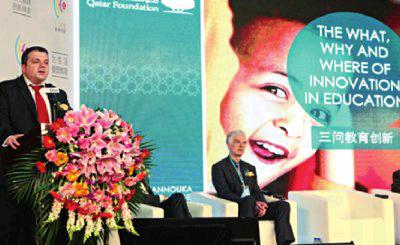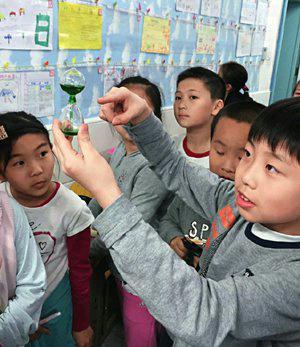Nurture Children’s Creativity
By+staff+reporter+ZHOU+LIN
THE year 2015 marks Chinas new era of mass “entre- preneurship and innovation.”
World Innovation Summit for Education (WISE) CEO Stavros N. Yiannouka observed in a recent interview that both developed and developing countries of the world are experiencing a bottleneck in economic growth. A transformed economic model is their only way out of it, as creativity and innovation supersede manufacturing and production amid the process of industrial upgrading. Education, however, does not meet the demands of this development trend in many countries. It instead continues to churn out a non-specifically capable work force rather than the more specialized and creative talents that are needed.
Yiannouka went on, picking up his cell phone, “Any number of people own iPhones these days, but although 90 percent of their components are made in China, 95 percent of the profit on each one flows back to the U.S.s Silicon Valley. Design and creativity are obviously the predominant features of this value chain.”
Respect Childrens Curiosity
Why does a four-year-old child ask 100 or more questions every day?
And why, the longer he is in education, does this tendency diminish? Tony Wagner from the Harvard University innovative laboratory believes that school weakens an individuals inherent creativity. We now face the challenge to reverse this phenomenon.
How can childrens creativity be protected? Respecting their essential qualities and encouraging their interests is crucial. Principal of Tsinghua University Primary School Dou Guimei told the story of a student named Li Jiahua.
As a child, Li showed a deep interest in all kinds of worms and insects. His father, a professor in the Physics Department of Tsinghua University, was puzzled at his sons hobby, since no one else in the family had a background in biology.
Although the boys father was proud of his sons gift in this field, he also worried that the hobby would interfere with his studies. Li was at the critical point of graduating from primary to middle school. Most of his classmates were attending extra-curricular classes. Lost in this quandary, Professor Li asked advice from his sons teachers. They advised him to let the boy pursue his hobby, and to encourage him to continue writing his observations on insects in his diary.
With the support of both parents and teachers, Li spent his holidays observing and studying insects throughout the nation and around the world, and even ventured into rain forests. He recorded his copious findings in his diary.endprint
“Our educational aim should give priority to childrens needs,” Principal Dou said. “We should respect childrens essential qualities and nurture their curiosity, encouraging them to solve problems creatively and so gain confidence.” The school accordingly provided Li with opportunities to share his passion with other entomologists.
When Lis first book, The Social World of Insects, was published, the school invited celebrated Nobel Prize laureate and Tsinghua University alumnus Yang Zhenning to meet him. The 92-year-old scientist was thrilled on hearing Lis story, and expressed his admiration for the boy when he signed a copy of the book. He agreed that teachers should pay close attention to childrens interests and do their utmost to cultivate their creativity.
Lis father was deeply moved, “Of every 100 scientists, only one has the potential to become a popular science writer. Li Jiahua may be one in the future.”
Young Li now has sufficient confidence to stand before a sizable audience and give entomological talks.
Tap Teachers Potential
In the traditional education system, cultivating childrens creativity relies largely on teacherscompetence. This includes innovative ideas, ability to organize activities, and an innate innovative demand and drive.
In Organization for Economic Cooperation and Development tests to measure levels of education, primary students in Finland always come top, and there is little difference among achievements at different schools. What is reason for this educational miracle in Finland, a country with a population of only 5.4 million? A survey by the Helsingin Sanomat, Finlands most widely read newspaper, shows that primary and secondary school teachers enjoy public esteem equal to that of the Finnish president and university professors. Teaching is a sought-after profession among the youth in Finland because it is a chance to become involved in creative learning rather than just teaching knowledge.
In 2005, the 21st Century Education Research Institute conducted a joint survey with learning. sohu.com of 3,012 primary and secondary school teachers from 28 provinces, municipalities, and autonomous regions. The results show that the majority were aware of the importance of innovation in education, and of the urgent need to carry it out.
How do teachers innovate? And if a teacher intends to make changes, how can this be achieved? Xu Li from Wuchang Experimental Primary School believes that unsolved problems are often the starting point for innovation. “I have discovered after 18 years as a teacher that all improvements stem from the desire to solve problems. Questioning voices have been my creative motivation.”endprint

The survey also shows that teachers in urban private schools are more confident in this respect than those in public schools. The former group often believes that teaching can be improved through personal efforts. Green-hand teachers with one to four years experience expressed a strong desire for innovation without outside pressures. Among the modes of innovation, several were advocated, including reforms to curricula, teaching and research, school management institutions, educational technology and evaluation, and professional teacher development. These findings reflect the importance that Chinese schools attach to innovation, and enhancement of teacher ability.
Close to half of teachers surveyed – 47.8 percent– however, said that innovating while fulfilling existent teaching demands was difficult. A further 57 percent believed that innovations couldnt be achieved solely through teachers personal efforts, and that it would be hard to produce substantive results within schools under the current situation.
Shed Shackles of Tradition
“To encourage creativity, we must change the objective of school education from that of training young people to be laborers to cultivating true humanity. True reform that encompasses thought as well as innovation and brings human creativity back to the campus is evident in the human enthusiasm that stimulates childrens creativity,” special educational correspondent Jiang Xueqin of The New York Times said.
Founder of the Internet educational platform www.hujiang.com Fu Cairui shared his reflections on education, how to shake off the shackles of tradition and give full play to our creative minds.
Fu said that it was only when he first used the Google search engine at college that he realized he was not born to learn knowledge by memorizing books. “I could find out anything I wanted with a click. It was an epiphany that made me realize there was no need to go back to campus because I could learn independently.”
Active learning has a huge potential market. “We have 800 workers and 80 million users, all of them active online learners. The value of our website has grown from RMB 80,000 to US $one billion, and the number is still rocketing.”
Fus decision to start his own business was met with suspicion and dissuasion from both teachers and friends. They all urged him to follow in the footsteps of students who had begun earning salaries after graduation rather than taking the risk of being an entrepreneur.endprint
Fus mother, in contrast, told him to do whatever he liked other than crime. Fu feels lucky to have come under the influence of such an understanding mother.
It took Fu nine years to earn his first penny.“While building the website I never thought I would be a millionaire. Despite its first simple, unrefined contents, there were still many active users then from schools. All my efforts were encouraged by people on campuss constant text messages encouraging me to persevere, and telling me I was doing something outstanding.”
When talking about innovative ability, Fu expressed his belief that the most important ability is that of accomplishing the career upon which you have embarked. “Anything, no matter how small, deserves dedication and fulfillment. Persisting until you succeed is unbelievably gratifying.”
“Educational innovation is essentially valueorientated cultural behavior rather than technical training. It aims at inspiring childrens life values during the education process. Only when students discover their own such values can they pursue dreams in the future. This is the genuine significance of education innovation,” concluded deputy director of Shanghai Municipal Education Commission Yin Houqing.endprint

